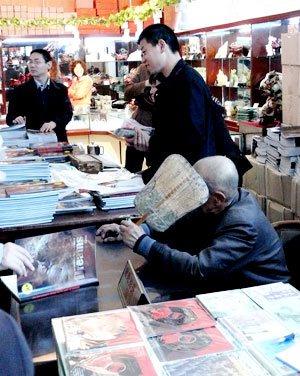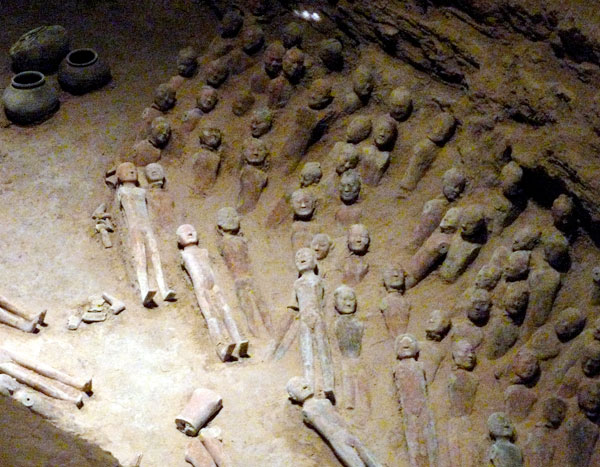XI’AN, CHINA - We were warned not to take out our cameras and try to photograph the old man hiding behind the hand-held fan.
“He will not allow anyone to take his photograph,” said our guide Zhong Yu (Jade) as we entered a gift shop opposite the brilliant Terra Cotta Warriors Museum where we spotted the withered old man, known as Yang Peiyan.
Mr. Yang was one of three farmers who discovered the 2,000-year-old Qin Dynasty burial tomb, guarded by a clay army now known as the Terra Cotta Warriors, while digging a well in 1974 on the outskirts of this ancient Chinese capital.
Now, Mr. Yang is as famous as the warriors he discovered.
“If you take out your camera, he will get very angry and will yell at you,” Jade cautioned us.
Despite the warnings, people still try to steal Mr. Yang’s image.
“Ni gan shim ma (what are you doing)?” shouted the camera shy Mr. Yang as an unsuspecting German tourist pointed his camera in the direction of the Chinese icon.
“Zo kai (go away)!” Mr. Yang, now 79, demanded as an attendant rushed over to the tourist and politely asked him to hide the camera.
As other tourists arrived, the old man took refuge behind his bamboo fan and scowled every time someone took out a camera.
He spotted me with my Leica at the ready and gave me a warning glare.


Above: Yang Peiyan, the farmer who unearthed the Terracotta Army, refuses to let strangers photograph him.
No one is sure why Mr. Yang doesn’t like having his picture taken - “probably so many people have asked over the years, he’s tired of it,” offered Jade - but he doesn’t mind autographing books that tell the story of his remarkable find - for a price.
“That will be 120 yuan (about $17 Cdn.) an attendant told each of the tourists who brought the book to be autographed personally by Mr. Yang.
The book chronicles the discovery of the warriors, which have become a major tourist attraction in this city where 72 emperors lived over a 1,200-year period, and Mr. Yang gets a cut of the action.
Mr. Yang’s portion of the book sales is far more than he got for finding the Warriors.
“He was paid just 50 yuan (about $8) by the government for the find,” said Jade. “But he has made much more signing his books for the tourists.”
And there are plenty of tourists who visit the Terra Cotta Warriors site - over three million last year alone. That number is expected to hit five million in 2008 when the country hosts the Summer Olympics in Beijing - a two hour flight away.
Before the warriors were unearthed, few people visited Xi’an, a place where the famed Silk Road that connected Asia with Europe started, and where over 300,000 Chinese Muslims, mostly descendants of the early traders, still live.
“When the Terra Cotta Warriors were discovered, we had no major hotels in Xi’an,” said Jade of her hometown which has 70 universities. “Our oldest hotel dates back to 1984.”
Now several major western chains have hotels in Xi’an and its streets are packed with tourists who come to see the warriors built to protect Emperor Qin Shi Huang and his court in the afterlife. When they get here, travellers also find the only walled city in China and many other historic attractions.
Xi’an is surrounded by thousands of burial sites, China’s answer to the pyramids, but few have been excavated.
There are over 6,000 warriors on display in the three pits that make up the fascinating museum. All are terra cotta in colour but they did not go into the ground that way.
“They were all brightly painted but when they were uncovered, oxidization stripped them of their colours and they returned to their clay base,” offered Jade.
The warriors were found broken into hundreds of small pieces.
“Two years after the emperor died - he was killed in his early 50s - the workers had not been paid so they returned to the pits and destroyed all the warriors and almost everything else buried alongside the emperor,” said Jade.
Mr. Yang long ago moved out of the modest farmhouse he lived in at the time of the discovery - “he now lives in a very nice house thanks to the money he gets from the book signings,” said Jade.
Jade was unsure of what happened to the other two farmers - “I read somewhere that they both had died.”
I was determined to get the old man’s photograph and stalked him for over 30 minutes with limited success. Every time he lowered the fan to sign a book, I readied my camera. But by the time I brought the view finder to my eye, Mr. Yang had ducked behind the fan again.
Jade watched the cat and mouse game go on for a few minutes before suggesting the old man would never be beaten.
“He has become an expert at ducking the camera,” said Jade, who got to know Mr. Yang when she was one of the guides used at the Terra Cotta site during former U.S. president Bill Clinton’s visit.
“But on the day of Mr. Clinton’s visit, Mr. Yang got very nervous and instead of asking `how are you?’ he asked the president `who are you?’ to which Clinton responded `I’m Hillary’s husband.
“Mr. Yang then said: `Me too,’” laughed Jade.
The old man’s eyes followed my every move. He was far more determined than I. Finally, Jade said it was time to go.
“Just give me a few more minutes - I’m sure I can get the picture without him knowing,” I told the guide.
“Sorry,” said Jade, “but we will be as old as the Terra Cotta Warriors before Mr. Yang gives up his image.”